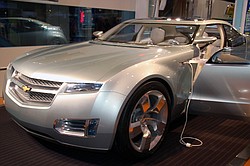Competition heats up to be battery supplier for Volt
The 2008 Chevrolet Volt Concept at the Cleveland Auto Show.
GM plans to reach 100,000 sales a year with its new electric car.
WASHINGTON (AP) — The competition to become the battery supplier for the Chevrolet Volt is a “horse race,” and plans are on schedule for a late 2010 launch of the vehicle, a top General Motors Corp. executive said Tuesday.
Vice Chairman Bob Lutz, who is overseeing the development of the extended-range plug-in electric vehicle, said the automaker had hoped to name a battery supplier in April. There are two competing developers.
But GM wants to “run the two in parallel for a while longer” as it continues to test the battery packs under a variety of conditions.
“It’s a horse race,” Lutz said in an interview with Washington-based reporters. He said both suppliers “have extreme strengths and some weaknesses, but the balance of strengths and weaknesses are different between the two potential suppliers.”
GM signed development contracts with Compact Power Inc. of Troy, Mich., which is developing battery cells with its parent, LG Chem of Korea, and Frankfurt, Germany-based Continental Automotive Systems, which is using cells being developed jointly by GM and A123 Systems Inc., which makes lithium-ion batteries for use in cordless power tools.
The Volt, which GM views as a mainstream vehicle that could be recharged by being plugged into a household outlet, has been closely watched by the industry. The vehicle would be powered by an electric motor fed by lithium-ion batteries.
The vehicle is part of GM’s strategy to produce a wide range of alternative vehicles. Lutz estimated that by 2015, between one-quarter and one-third of the vehicles GM sells will be some form of a hybrid-electric or alternative-drive vehicle to meet recently approved federal fuel economy standards.
He estimated that GM would sell about 100,000 Volts a year by 2012.
Fully charged, the Volt could drive around 40 miles without using any gasoline, and a small conventional engine would recharge the vehicle, extending its range and allowing it to get the equivalent of 150 miles per gallon.
Lutz said the automaker remains on pace for a late 2010 launch of the Volt and expressed confidence in its future.
“We are doing all of that testing and so far, I will say, no failures, no problems. The battery technology is working great,” Lutz said. He added that the obstacles it faces in developing a suitable battery “aren’t fundamental electrochemical problems. These are simple engineering problems” which could be overcome.
 43
43

